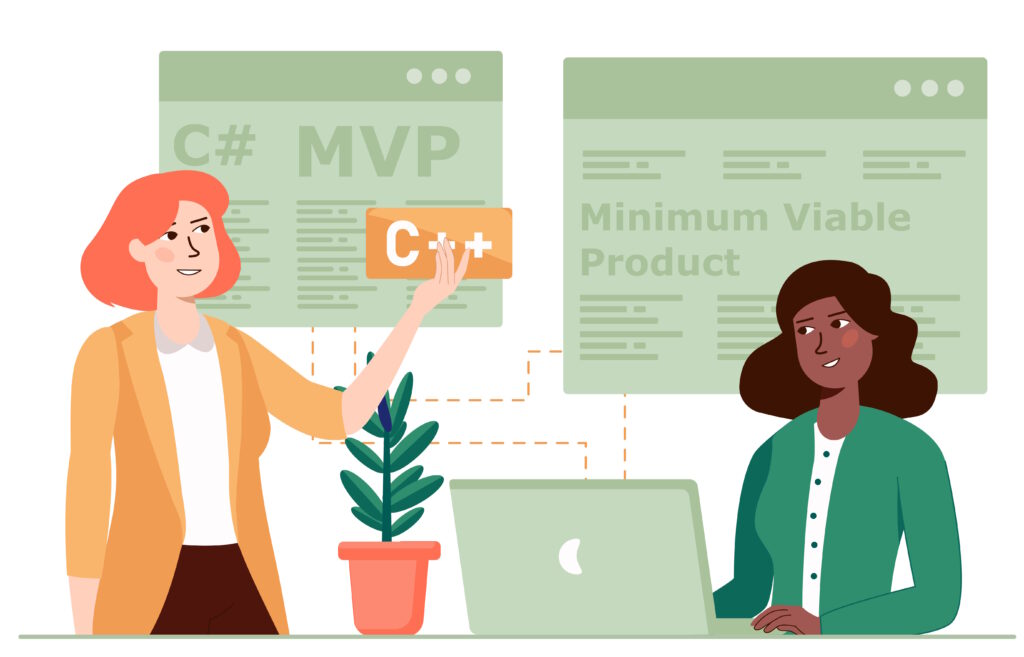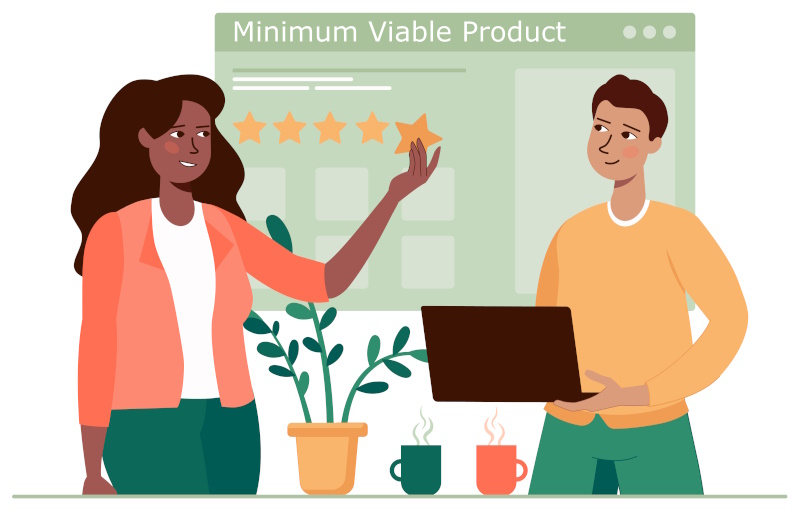Introduction to MVP Minimum Viable Product
When a company starts thinking about new software, there is often a big question hanging in the air: how do we begin? Should we build everything at once, or start small and grow? The safer, smarter path is often to create an MVP minimum viable product.
An MVP minimum viable product, is the first usable version of your software, designed with just enough features to solve a real problem and to prove the value of the idea. Instead of paying for everything in one go, you start with the ‘must have’ essential features. From there, you can test, learn, and decide what should come next.
MVP Minimum Viable Product: Literal Explanation
An MVP minimum viable product is not a sketch or a flimsy demo. It is a functioning piece of software that handles a specific business need. The idea is to keep it small but valuable, avoiding wasted effort on features that might not even be needed.
- Minimum 🧩 – represents the smallest possible amount, something compact or essential.
- Viable ✅ – represents success, functionality, or something that works as intended.
- Product 📦 – represents an item, creation, or deliverable designed to meet a need.
When these three come together, to make – minimum viable product, you get:
The smallest version (minimum) of a product that works and delivers results (viable).
An MVP minimum viable product is not a rough sketch or a half-built demo. It is a functioning piece of software or service, designed to tackle a real business problem.
- Example 1 🍔📲 – Imagine a meal delivery app that lets customers order and pay in two taps, instead of offering a dozen extra features nobody asked for.
- Example 2 📰💻 – A subscription website that launches with just core content, enough to see if people will actually subscribe.
The focus is small, practical, and purposeful, avoiding wasted effort on anything that may not matter. So, what is a minimum viable product in practical terms? It is the simplest version of software that works in the real world and demonstrates whether you are on the right track. That is the essence of the mvp definition.
The History and Origins of the MVP Concept
The phrase minimum viable product came from the Lean Startup movement. Eric Ries wanted to help young businesses test ideas before running out of money. The idea was simple but powerful: instead of spending years polishing a product, build a basic version, put it in front of real users, and see if it actually matters.
| Eric Ries – The Lean Startup (2011). Ries described the MVP as: 💬“the version of a new product which allows a team to collect the maximum amount of validated learning about customers with the least effort.” |
Why the MVP Was Crucial for Startups
For startups, time and resources are precious. A single misstep can drain cash or sink an idea entirely. The MVP minimum viable product allowed founders to focus on what truly mattered: validating the concept with real feedback.

Imagine a new mobile app that promises home-cooked meal deliveries. It launches with every possible feature:
- Ability to order and pay for meals
- Custom meal plans
- Loyalty points
- Social sharing
Alternatively, an MVP could launch with the functionality to just let customers order and pay. This simple approach allows a startup to test the main idea and if successful, they can then develop the extra features with confidence, knowing there is a market for their product. On the other hand, if little interest is shown, the app can be abandoned early, before huge amounts of resources have been poured into a product with no market.
In essence, the MVP helps startups fail fast but wisely. It turns assumptions into data and guesses into insights. This early validation often decides whether a business survives or pivots in time.
How and Why the MVP Spread to More Established Companies
While startups popularised the MVP, established companies quickly saw its value. Big firms could test new ideas without a huge budget. For example:
- A manufacturer might trial software that automates one part of its supply chain.
- A professional services company could pilot a simple client note system.
In both cases, the MVP minimum viable product shows whether an idea works in practice before investing heavily.
Over time, the approach became standard in sectors from manufacturing to finance. Businesses realised they could innovate safely, experiment with new offerings, and avoid costly mistakes. The lesson is clear: whether you are a scrappy startup or a century-old company, testing small, learning fast, and building only what matters is a winning strategy.
The Business Case for MVPs
Building software can be expensive. Projects often balloon in cost and complexity when companies try to fix every possible issue in one massive rollout. Deadlines can slip and budgets may spiral. The final product may not even meet the needs of the people who will be using it.
An MVP minimum viable product offers a smarter path. By focusing on the most critical problem first, businesses reduce risk and gain clarity. Work happens in smaller, measurable steps. You invest less, test assumptions early, gain user feedback and avoid wasting years building features nobody uses.

The benefits of an MVP minimum viable product are clear:
- Lower Costs 💰 – Smaller projects mean smaller budgets and less financial exposure.
- Faster Results ⏱️ – Teams can deliver usable software quickly, capturing value sooner.
- Clearer Feedback 📊 – Real-world use shows what works, what doesn’t, and what should come next.
- Reduced Risk ⚠️ – You avoid committing to large, untested systems that may fail.
This approach works whether you are replacing endless spreadsheets, improving customer tracking, or cutting down on manual reporting. The MVP gets you to practical value fast, without locking the business into years of uncertain development.
Real-World Scenarios of MVPs in Action
To make this clearer, here are a few ways an MVP minimum viable product might look across different sectors:
- 🛍️ Retail: Instead of building a full stock and sales system, the MVP might focus only on recording deliveries and tracking best-selling products.
- 🏥 Healthcare: A clinic may want a full patient management platform. The MVP could begin as a booking system that handles appointments and nothing more.
- 🚚 Logistics: A courier firm might dream of advanced routing and real-time traffic data. The MVP could be a simple system that logs when parcels leave and arrive.
- 📊 Professional services: A consultancy may want end-to-end project management software. The MVP could be a time-tracking tool that shows where billable hours go.
In each case, the MVP proves value without taking on everything at once. That is why the mvp definition is so powerful in practice.
MVP Myths to Avoid

Even with its popularity, the MVP minimum viable product is often misunderstood. These myths can mislead teams, waste resources, and derail projects. Understanding them is essential to grasp what is a minimum viable product and why the MVP definition matters.
❌ Myth 1: An MVP is Low Quality
Some developers assume that “minimum” means rough or unreliable. This is not true. An MVP must work consistently and deliver genuine value. It should be built to the same standards as any software launch, with careful attention to usability and performance.
❌ Myth 2: MVPs are Only for Startups
Many believe MVPs are exclusively for small, early-stage businesses. In fact, large organisations benefit just as much, if not more. Big companies face the challenge of high stakes and complex systems, making failed launches costly. Therefore, using an MVP minimum viable product allows these firms to test new ideas, features, or services on a smaller scale, allowing them to decide whether further investment would be beneficial.
❌ Myth 3: MVP Means Cutting Corners
An MVP is not about skipping important work. It is about prioritising the features that deliver the most value first. The focus is on solving the core problem effectively. Additional functions or enhancements can be added later, once the main idea proves successful and stakeholders have confidence in its potential.
Recognising these myths helps clarify the purpose and power of an MVP minimum viable product. It is a tool for learning and reducing risk, ensuring teams make informed decisions and avoid wasted effort.
MVP vs Other Approaches
An MVP minimum viable product sits in a unique place compared to other approaches. It is not a full launch, which tries to solve everything in one go. Nor, is it a “proof of concept”, which simply shows whether something is possible but does not deliver ongoing value.
The MVP is different: it is the first usable version of software, designed to solve a real business issue right now, while leaving space to grow later.
| Approach | What It Means | Risk Level | Outcome |
|---|---|---|---|
| Proof of Concept | A quick model to show an idea is technically possible | Low | No lasting value, just a demo |
| Full Product Launch | Complete system built before real-world use | High | Risk of wasted investment if users reject it |
| MVP Minimum Viable Product | A working version with only the most vital features | Medium – Low | Immediate value, plus learning to guide future growth |
The Risk of Skipping an MVP
What happens if a business skips the MVP step? The danger is ending up with expensive software that no one wants to use. Imagine spending £100,000 on a new system only to find staff prefer their old spreadsheets. Or rolling out a grand customer portal that customers ignore.
An MVP minimum viable product avoids these traps by showing what works early, before money and time are sunk into features that miss the mark. It is a shield against wasted investment.
Moving from the MVP, the Role of Feedback
Once the MVP is up and running, the client’s role is to use it, gather feedback, and think about what would make it more effective. They decide what matters most for their users and set priorities for the next stage.
The goal is not just to launch quickly but to learn. Once the software is in real use, feedback from staff or customers shows what works and what does not. That learning helps you decide which features are worth adding, and which ideas are better left behind.
This is why the MVP definition emphasises both “minimum” and “viable.” It must be useful enough to generate feedback but focused enough that you can adapt without waste.

Thinking Ahead After Your MVP
Once your MVP minimum viable product is proving itself, the next step is to expand. But it should be done carefully. New features should only be added when you know they will make a real difference. Feedback from the MVP stage should guide every decision.
Over time, your software will become richer, more capable, and tailored to your business. The difference is that growth happens without wasted effort. You only invest in what has already shown its worth.
The software developers then take this feedback and build on the MVP. Their role is to improve the product step by step, adding features, making it smoother to use, and ensuring it can grow without breaking.
Together, the client and the developers turn the MVP into something even more valuable — not just a starting point, but a product that truly supports its users.
The next question is how to manage that growth. The method matters as much as the idea. This is where Agile development comes into play, giving you a structured way to expand in steps, respond to feedback, and keep software aligned with business needs.
Final Thoughts on the MVP Minimum Viable Product
So, what is a minimum viable product? It is the simplest working version of your software that solves a real business need. The mvp definition is not about doing less for the sake of it, but about doing the right amount to prove value early.
For businesses, this means avoiding wasted investments, testing ideas quickly, and building software that truly fits. At BSPOKE Software, we help companies do exactly that, by creating MVPs that are fast to launch, easy to use, and built to grow when the time is right.
If you are considering new business software, an MVP minimum viable product is the smartest first step. Contact BSPOKE today, for an informal chat or to book an initial consultation.

